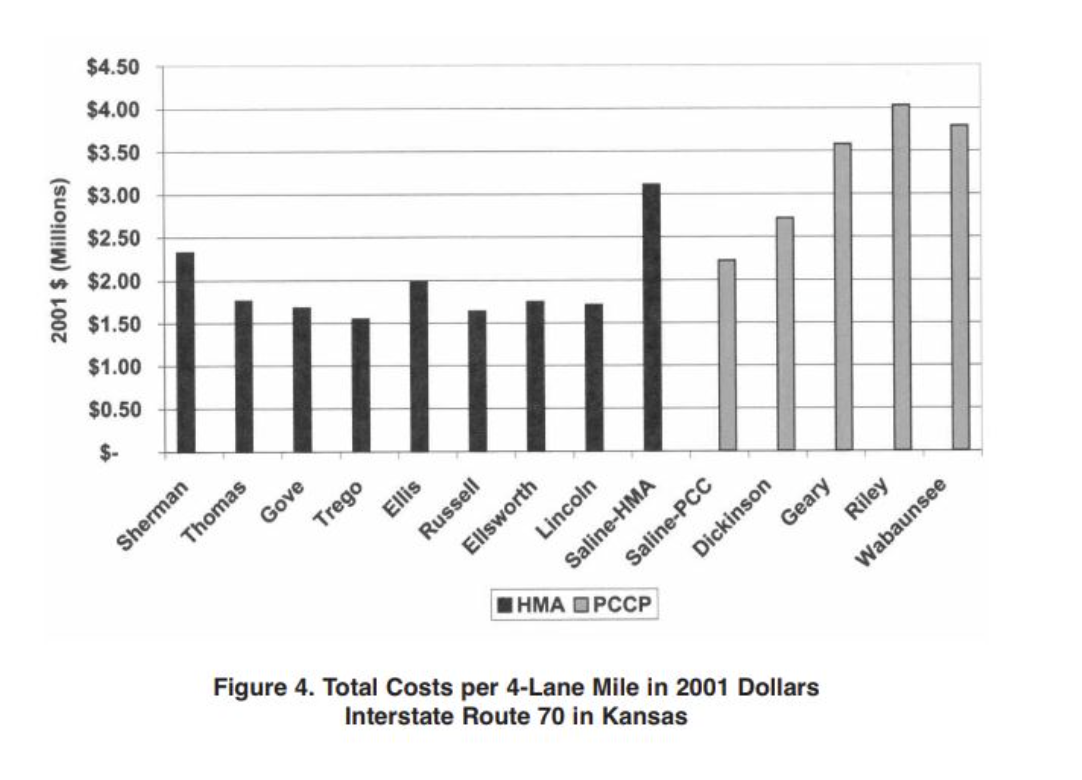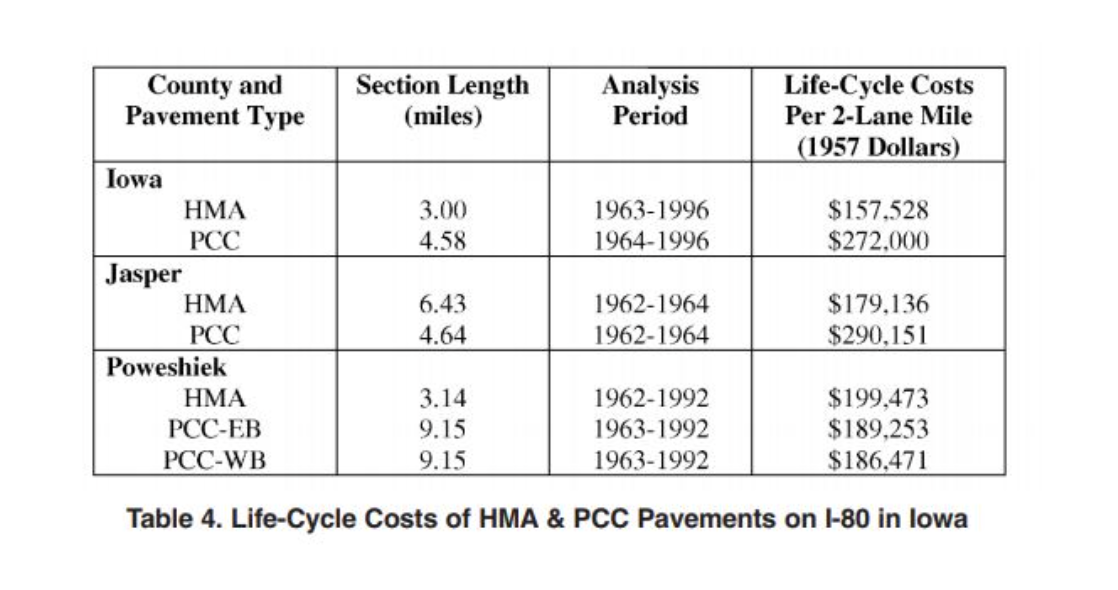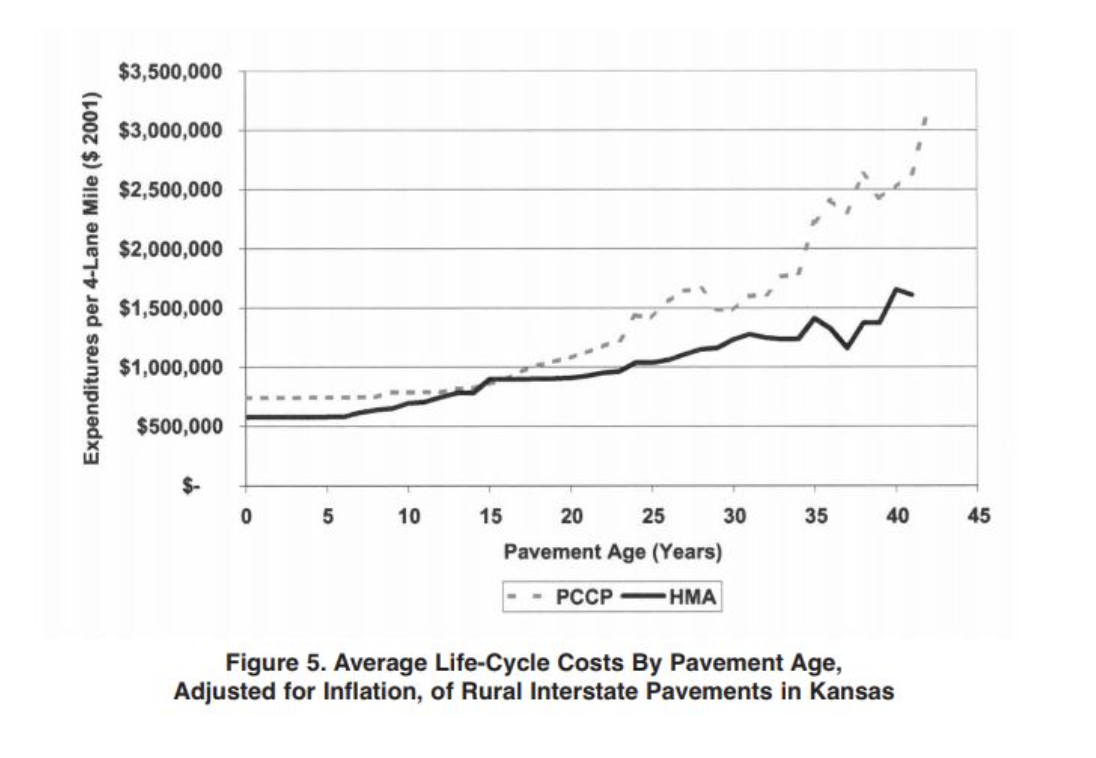Asphalt Highways Are Less Expensive
A 1994 hallmark study of asphalt and concrete interstate pavements proved asphalt’s superior value.
EDITED BY CHUCK MACDONALD
Americans like getting their money’s worth, whether it’s with the houses they buy, the phones they use, or the cars they drive. It’s also true about the roads they drive on. A comprehensive study1 revealed that asphalt roads were more economical than concrete in Ohio, Kansas, and Iowa. The life cycle cost analysis (LCCA) in this study was based on actual costs of existing pavements over a given time using historical data from the road-building agency. In all cases, comparisons were made to the greatest extent possible of asphalt and concrete pavements carrying similar traffic and comparable age.
Comparing Nearby Pavements
The 3 studies were diverse in their approach to the question of which pavement type is more economical.
- The Ohio study included 5 locations on 4 interstate highways (I-71, I-75, I-475, and I-275) where asphalt and concrete pavements were constructed in close proximity and at approximately the same time. The costs were calculated per square yard of mainline pavement. Researchers used the present worth method of costs, wherein the costs during the analysis period of each project were discounted to the year of the original construction.
- The Kansas study examined approximately 218 miles of concrete pavement and 262 miles of asphalt pavement on rural interstate highways across the state. Comparative costs were calculated using the "4-lane mile of mainline pavement" as the unit of measure.
- The Iowa study examined 3 locations on 1 interstate route where asphalt and concrete pavements were constructed adjacent to each other at nearly the same time. The comparison of costs was made using the "2-lane mile" as the unit of measure.
The Results
The Ohio results showed that in all cases the initial construction costs of asphalt pavements were about 10 to 25 percent less than the concrete pavements on the same route. The cost savings for the present worth values (or total discounted costs) of asphalt compared to concrete pavements were even more dramatic, ranging from 13 to 107 percent, with most of the savings in the 25 to 70 percent range.
In the Kansas study, the compared pavements were not the same age, therefore equitable comparisons could not be made using the net present value (or worth) method. The comparisons were made using inflation adjusted dollars. An annual inflation rate of 3.5 percent was used, and all costs were carried forward to 2001 and referred to as "2001 dollars." A total of 218 miles of concrete pavement and 262 miles of asphalt pavement on 3 interstate highways were evaluated. The asphalt pavement on I-70 extends about 250 miles from the western border of the state to I-135 in central Kansas. The concrete pavement is in 3 locations: 95 miles on I-70 east of I-135; 68 miles on I-135 south of I-70; and 55 miles on I-35 in the eastern part of the state.
The 9 sections of asphalt on I-70, 1 each in 9 counties and 249.7 miles in length, had an average life-cycle cost of $1.89 million per 4-lane mile in 2001 dollars. The 5 sections of concrete on I-70, 1 in each of 5 counties and 95.1 miles in length, had an average life-cycle cost of $3.22 million per 4-lane mile in 2001 dollars. See Figure 4 below1:

The Iowa study determined total life-cycle costs by calculating the present worth of costs of selected pavements discounted back to 1957 dollars using a discount rate of 4 percent. Three sections each of concrete and asphalt pavement on I-80 in 3 counties between Des Moines and Iowa City were analyzed in the study.
In Iowa County, the 4.58-mile concrete section had present worth costs of $272,000 per 2-lane mile. The adjacent asphalt section, 3 miles long, had present worth costs of $157,528. The 4.64-mile section of concrete pavement in Jasper County showed total costs discounted to 1957 dollars of $290,151 per 2-lane mile, while the adjacent 6.43 mile section of asphalt pavement had total costs of $179,136 per 2-lane mile.
The costs are shown in Table 4 below1.

Conclusions
The results of the studies show that asphalt pavement was overall more economical in both initial construction cost and life-cycle costs than comparable concrete pavement. In Ohio, all 5 of the areas compared showed lower initial construction costs and life-cycle costs for asphalt pavement.
In Kansas, the 10 asphalt and 11 concrete pavement sections evaluated on 3 interstate routes showed that asphalt was substantially more economical over the life of the pavement. Initial construction costs of 9 asphalt pavement sections in Kansas averaged less than those of 5 concrete pavement sections on I-70, but 1 asphalt pavement section on I-35 had a higher initial construction cost than the average of 3 concrete pavement sections on the same route. See Figure 5 below1:

In Iowa, two asphalt pavement sections were substantially more economical over the life of the pavements than the comparable concrete sections, and 1 concrete section was slightly more economical in life cycle costs than the comparable asphalt section.
- APA. Pavement Life-Cycle Cost Studies Using Actual Cost Data: A Synthesis. February 2005.
Chuck MacDonald is a writer living in Annapolis, Md. He has been a frequent contributor to projects for NAPA and other organizations.